U.S. Department of Transportation
Federal Highway Administration
1200 New Jersey Avenue, SE
Washington, DC 20590
202-366-4000
Sign up to have Safety Compass delivered right to your inbox!

Best for printing: PDF Version (1.48 MB)
In this issue:
A Message from the FHWA Associate Administrator for Safety, Cheryl Walker
What's New?
Safety-Driven Changes and Improvements
Mainstreaming Safety Improvement — How Agencies Are Assessing Safety on All Projects
Addressing Motorcyclists' Safety Issues
Safe Transportation for Every Pedestrian (STEP) UP Focuses on Five Key Pedestrian Safety Issues
Advancing the Safe System Approach through Intersections
Commuter Authority Rail Safety Improvement (CARSI) Project Highlights
Learning Together
Advancing Implementation of the Safe System Approach: Resources You Can Use
Local Road Safety Plan (LRSP) Development in California
National Work Zone Awareness Week (NWZAW): "Drive Safe. WOrk Safe. Save Lives."
Data and Analysis
Contributing Factors for Focus Crash and Facility Types
FHWA Releases Report on the Impacts of Automated Vehicles on Highway Infrastructure
New Resource Roundup
FHWA Releases New Resources on Bikeway Selection
Announcements
New Logo for the Office of Safety!
Announcing the New Intersection Safety Web Pages!

Cheryl Walker, Associate Administrator for Safety.
Reducing fatalities and serious injuries—that's what each and every one of us is striving to do. To achieve this goal, we need to be intentional about improving safety for every road user. As we continue to research new ideas and implement solutions to safety issues, we need to ask crucial questions. How can we implement safety solutions equitably? How do we eliminate adverse impacts on underserved communities? While we still have a lot of work to do to build an equitable and safe transportation system, below are a few resources to help us advance this goal.
I'm pleased to share that many safety countermeasures featured on FHWA's safety pages improve both safety and equitable access to transportation. For example, a pedestrian refuge island is a median with a refuge area that helps protect pedestrians crossing a multilane road. This countermeasure is particularly helpful for elderly or disabled pedestrians who are slower to cross the road—it provides a place to rest and reduces the amount of time pedestrians are in the roadway. Backplates with retroreflective borders improve the visibility of the illuminated face of the traffic control signal for all drivers. This treatment enhances traffic signal visibility and conspicuity for both older drivers and color-vision-deficient drivers. Installation of a sidewalk results in a 65–89 percent decrease in crashes involving pedestrians walking along roadways. Continuous sidewalks and accessible pedestrian networks are critical to improving safety and mobility for ALL pedestrians—but especially older and disabled pedestrians—to access employment, services, and commerce centers.
I'd also like to highlight two new resources we recently published that can help you make your roads safer and more equitable for all users. Our new guide—Traffic Analysis and Intersection Considerations to Inform Bikeway Selection—features a section on equity-focused design principles to help agencies prioritize accessibility, safety, and equity for all users when designing intersections. The companion guide—On-Street Motor Vehicle Parking and the Bikeway Selection Process—encourages agencies to consider race, equity, and social justice in the planning and public policy discussion when considering bikeway type selection in the context of on-street parking. It outlines an eight-step process to help advance transportation equity by incorporating equity into all aspects of the transportation planning, design, and implementation process. You can read more about these new guides on page 17 of this issue.
I'd urge all safety champions to consider equity when advocating for, designing, and implementing safety improvements. Our roads are not truly safe unless they are safe for EVERYONE.

Jeffrey A. King. (Source: FHWA)

Karen Y. Scurry. (Source: FHWA)

Ken Kochevar. (Source: FHWA)
By: Patrick Hasson and Adam Larsen, FHWA
Each year, the safety discipline recognizes individuals for their leadership and accomplishments through its safety discipline awards. The discipline recognizes three individuals for its 20th annual awards:
Field Safety Peer Awards
Jeffrey A. King's passion and dedication for highway safety is evident in his abilities leading safety initiatives in Arizona and in his national contributions to the safety discipline. Jeff has educated division staff and Arizona partners on the Safe System Approach, Proven Safety Countermeasures, and Every Day Counts initatives. Jeff maintains partnerships with national, State, regional, local, and Tribal practitioners in transportation, law enforcement, and other disciplines. Through Jeff's efforts, Arizona has institutionalized STEP countermeasures. Jeff is an outstanding individual who represents the best of FHWA and those of us who are committed to advancing safety.
Karen Y. Scurry was selected for the Field Safety Peer Award based on nominations from six FHWA division office safety engineers. Karen has been instrumental in helping States advance their capabilities as they plan and implement highway safety improvement projects using a performance-driven process. This fact alone attests to her status as a highly respected resource in the safety community. Karen oversees the Highway Safety Improvement Program (HSIP) for the agency and has led the development of HSIP technical documents and tools including the Crash Modification Factor (CMF) clearinghouse. Recently, Karen led the effort to bring together 50 States and two territories for a national safety peer exchange and subsequent annual virtual regional safety peer exchanges. Karen's dedication to the safety profession, the discipline, and FHWA is the among the finest cases of leadership by example.
Howard Anderson Lifetime Achievement Award
Ken has had an impact on the highway safety profession and community both in California and across the country. He has served the transportation safety community as an FHWA employee since 1988. Ken served in multiple positions throughout that time and is currently the safety program manager in the FHWA California Division. For more than 32 years, Ken has demonstrated division, statewide, and national leadership in advancing innovation and showing dedication, as well as an unparalleled passion for championing traffic safety in the many activities he has led. Whether volunteering or being invited to lead, Ken has been engaged in numerous safety-improving and impactful activities throughout his career. Ken will be retiring soon and will leave a legacy of passion and commitment to safety.
It is for this dedication to a lifetime of improving highway safety and commitment to quality that Ken is receiving the Howard Anderson Lifetime Achievement Award.
Field Leadership Safety Award
This year, for the first time, the safety discipline is introducing the Field Leadership Safety Award to recognize a division administrator, deputy division administrator, or Federal Lands Division director for outstanding leadership that advances safety. The winner of this award will be announced at a later date.
For more information, please contact Adam Larsen at adam.larsen@dot.gov.
By: Bruce Hamilton, Managing Director, Roadway Safety Foundation
The FHWA has again teamed up with the Roadway Safety Foundation (RSF) to cosponsor the 2021 National Roadway Safety Awards.
Every 2 years, this prestigious awards program honors public agencies and organizations in the transportation community that have developed innovative safety plans or implemented data-driven engineering or operational improvements that significantly reduce deaths and serious injuries. Criteria for determining winning projects include effectiveness, innovation, and resource efficiency. Awards are given in two categories:
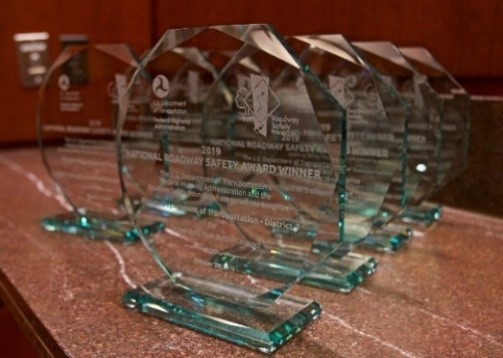
National Roadway Safety Award. (Source: FHWA)
Selected projects and programs are included in a noteworthy practices guide so they can be replicated nationwide. Award winners are also honored at a ceremony with senior U.S. Department of Transportation (USDOT) officials on Capitol Hill and receive assistance generating positive media coverage in their home communities. For more than 2 decades, this program has shined a spotlight on practitioners who are the unsung heroes of highway safety, and we are delighted to be able to keep the tradition going once again. At this time, we anticipate holding an in-person luncheon ceremony this fall; however, contingency plans for a virtual event are also in the works.
Know of a Groundbreaking, Innovative Road Safety Project or Program?
Applications are being accepted through May 28, 2021. Note that only public agencies may serve as lead applicants for an award; however, nonprofits or private entities may cosponsor a submission provided they are in partnership with a public agency.
For more information, please contact Norah Ocel at norah.ocel@dot.gov or Bruce Hamilton at brucehamilton@roadwaysafety.org.
By: Rosemarie Anderson, FHWA Office of Safety
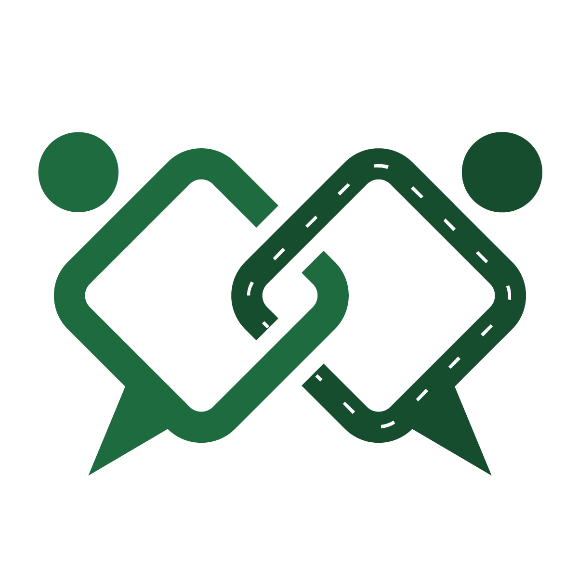
MATCH program logo. (Source: FHWA)
FHWA recently launched the MATCH program to provide broad-based technical assistance to local and Tribal agencies facing roadway safety challenges. The program connects agencies requesting assistance (mentees) with peer mentors who have specific expertise to help successfully address the identified challenges. The technical assistance is free for mentees, and mentors volunteer their time to help peers.
Local and Tribal agencies own and operate approximately 75 percent of the Nation's roadway network, many of which are in rural areas. Although FHWA and State departments of transportation (DOT) have a history of working with local and Tribal agencies to improve safety on local and Tribal roads, only a finite number of safety practitioners in the multitude of local road agencies can be reached. This program will augment efforts by FHWA and support local and Tribal road practitioners with integrating safety into their roadway programs. The diversity of these agencies leads to a variety of ways that roadway safety problems are addressed and evaluated. This means there are varying degrees of success of safety implementations, and a mentoring program allows for the potential to learn from and build on previous experience from peers.
Local and Tribal agencies often face unique safety challenges on their roads involving roadway departure, intersection safety, speed management, and pedestrian and bicyclist safety. The MATCH program leverages the mentor's knowledge and experience to provide short-term technical assistance to local and Tribal agencies wanting to resolve safety or safety-related concerns or issues. Mentors will assist in identifying the problem and recommend appropriate strategies for implementation when paired with mentees. This enables mentee agencies to benefit from this knowledge to potentially save lives and reduce serious injuries on the roadways.
All local and Tribal agencies are eligible to apply for technical assistance from a mentor through the MATCH program. For assistance, prospective mentee agencies must fill out and submit a short online application. Requests must be directly submitted by a public official. When necessary, FHWA may coordinate with the mentee's respective State DOT or FHWA division office to support the mentoring request. Once a request is submitted, the program manager will reach out to the applicant within 48 hours. Upon approval for the program, the applicant will be matched with a mentor.
If you are interested in serving as a mentor, email MATCH@dot.gov and provide your name, agency (or prior agency if retired), job position/role, years of relevant experience, relevant certifications (if appropriate), and description of areas/expertise where you feel you would best serve as a mentor.
Public agency transportation safety professionals who have specific expertise related to local or Tribal road safety can serve as mentors. Mentors must be actively employed by or retired from a public transportation agency with a minimum of 5 years of continuous transportation safety experience. Mentor's schedules will be accommodated; however, they will be asked to make a commitment to assist the mentees. Both mentors and mentees will be required to produce a short report once the activity is completed in an effort to document and share noteworthy practices.
Mentoring can be provided in the form of phone calls, email exchanges, web conferences, or site visits. The level of mentoring will vary based on the mentee's needs. The MATCH coordinator will match mentors with mentees based on the required expertise and mentor availability and will identify the best mentoring delivery method.
Local and Tribal agencies interested in receiving technical assistance through the MATCH program should fill out the application available at /local_rural/MATCH.
To learn more about the MATCH program, visit /local_rural/MATCH or contact Rosemarie Anderson at rosemarie.anderson@dot.gov.
By: Phillip Bobitz, FHWA Office of Safety
If I were to ask you, How is safety incorporated in your agency's approach to delivering transportation projects? or, Is improving safety a goal or an afterthought on your projects?, I expect the responses would vary. The responses would likely be mixed with a few "it depends," and there would be a wide variety of approaches to integrating safety throughout all projects and programs.
Project funding, improvement type (e.g., new construction, preservation), and the safety culture of an agency can influence the extent to which safety is assessed and incorporated into projects, especially those outside the traditional safety engineering programs. However, safety should be a given on all transportation projects, not an addition or a secondary consideration. Regardless of whether the project purpose is safety-related, every project is an opportunity to improve safety.
Several State DOTs have implemented policies and procedures to incorporate safety assessments on all projects to assist in making meaningful safety investments that yield optimal safety performance. Here are a few examples of approaches that agencies have instituted to incorporate safety beyond the typical safety-focused projects.
"Regardless of whether the project purpose is safety-related, every project is an opportunity to improve safety."
– Phillip Bobitz
Washington State Department of Transportation's "Sustainable Safety Related Policy" requires all projects to complete a scalable safety analysis using its Safety Analysis Guide. The guidance provides information on the scope and methodology of a safety analysis by project type for each funding subprogram (e.g., preservation, mobility improvement, safety improvement) and each document needing a safety analysis (e.g., design analyses, interstate access requests, intersection control evaluations). The policy takes a performance-based practical design approach, and directs the use of effective and efficient resources, such as the Highway Safety Manual (HCM), to diagnose, quantify, and predict safety performance to achieve the goals of the Washington State Strategic Highway Safety Plan: Target Zero.
Wisconsin Department of Transportation (WisDOT) implemented the Safety Certification Process (SCP) to improve the efficiency of WisDOT's safety processes, increase consistency of safety analysis from project to project, and document the decision-making process. The SCP applies to all projects, except majors (per the State's definition), and consists of six elements: determining the project's potential safety concerns, validating historical crash data with crash vetting, determining safety mitigation strategies and countermeasures, evaluating the safety performance of mitigation alternatives, applying economic appraisals to potential safety improvements, and documenting through a safety certification document. This process has allowed WisDOT to be more efficient with its transportation funding and improve the overall safety performance of its system.
Louisiana Department of Transportation and Development (LaDOTD) established guidelines for safety improvements on preservation, rehabilitation, and replacement (PRR) projects. The guidelines require that a safety assessment process checklist be completed for all PRR projects to identify abnormal locations or overrepresented crash types. If any intersection, roadway section, or spot section is determined to be abnormal or shows an overrepresented crash type, safety countermeasures must be considered after completing a Road Safety Audit (RSA). If the project does not require an RSA, the districts need to fill out the LaDOTD's baseline safety improvements checklist and indicate if low-cost countermeasures have been considered. The low-cost countermeasures include items such as rumble strips, oversized signs, pavement wedge, and removing foliage to improve sight distances. The process has allowed LaDOTD to integrate safety improvements into PRR projects and has created a coordinated, department wide focus on safety.
Agencies can use a variety of safety assessment methods such as those noted above as they make investment decisions and develop projects. To reach our goal of zero deaths and serious injuries, it is going to take a collective effort and all of us to take ownership in safety. We must get to a point where safety needs are considered at every stage of the project development process, every investment decision considers the impact on safety, and every federally funded project includes appropriate safety features and improvements.
For more information, contact Phillip Bobitz at phillip.bobitz@dot.gov.
By: Guan Xu, FHWA Office of Safety
According to the latest Traffic Fact Sheet: Motorcycles, published by the National Highway Traffic Safety Administration (NHTSA) in 2019, in the United States motorcyclists represent more than 14 percent of traffic fatalities, while motorcycles represent only about 3 percent of registered motor vehicles and less than 1 percent of vehicle miles traveled. With the continued efforts by USDOT and its safety partners, motor vehicle (passenger cars, pickups, sport utility vehicles, etc.) fatalities have decreased during the past 2 decades. Unfortunately, motorcycle fatalities have increased significantly in the same period.
Pursuant to Section 1426 of the Fixing America's Surface Transportation (FAST) Act, FHWA established the Motorcyclist Advisory Council (MAC) in 2017. The mission of MAC, as required by the FAST Act, is to coordinate with and advise FHWA on infrastructure issues of concern to motorcyclists, including: 1) barrier design, 2) road design, construction, and maintenance practices, and 3) the architecture and implementation of intelligent transportation system (ITS) technologies.
Since its establishment, MAC has held five public meetings—three in person and two virtually—to discuss issues relevant to the three areas of concern and the development of MAC recommendations. In early 2020, MAC published Motorcyclist Advisory Council Recommendations to the Secretary of Transportation and the Federal Highway Administration, a recommendations report for the topics specified in the FAST Act.
FHWA has been collaborating with stakeholders toward achieving the goal of zero traffic deaths. In these efforts, motorcyclists' safety issues will need to be recognized and addressed. Upon receiving the MAC recommendations report, FHWA launched a project to investigate and implement MAC's recommendations for reducing motorcycle fatalities. The project will collect and analyze the current state of practice and state of research related to barrier design, roadway geometrics, maintenance practices, pavement design, and ITS technology concerning motorcyclists' safety. Determining the state of practice will lead to identifying implementation and research needs and corresponding projects to address MAC recommendations. The final products from the project will include:
All information related to MAC can be found on the FHWA Office of Safety website, including five MAC meeting minutes and the recommendation report.
For more information, please contact Guan Xu at guan.xu@dot.gov.
By: Rebecca Crowe, FHWA Office of Safety
It's as easy as 1–2–3…or 5! FHWA's STEP UP campaign is focusing on five key issues that include nighttime crossings, older pedestrians, midblock crossings, traffic speeds, and multilane crossings. STEP UP and learn how a variety of countermeasures can address each issue and improve pedestrian crossing safety!
Pedestrian Crossings at Night
In 2018, 76 percent of all pedestrian fatalities in the United States occurred during dark conditions Agencies should first consider installing overhead lighting and high-visibility crosswalks at pedestrian crossing locations. At intersections, overhead lighting is estimated to reduce all types of injury crashes by 27 percent; outside of intersections, overhead lighting is estimated to reduce all types of injury crashes by 23 percent. Rectangular rapid flashing beacons (RRFBs) can also alert drivers to pedestrians who are crossing in dark conditions.
Pedestrian Crossings between Intersections
Most pedestrian fatalities nationwide occur outside of intersections (74 percent of all pedestrian fatalities in 2018). People walking prefer to travel to their destination in the most direct or convenient path possible. A midblock crosswalk can accommodate a pedestrian's preferred crossing location and visually mark where motorists can expect to see pedestrians crossing. Countermeasures like RRFBs, pedestrian hybrid beacons (PHBs), and pedestrian refuge islands can improve the visibility of a crosswalk.
Crossings for Older Pedestrians
Older pedestrians are particularly vulnerable in the event of a crash—they are more likely to suffer increased levels of injury compared to younger-aged pedestrians. Pedestrians aged 65 and older are also overrepresented in pedestrian fatalities (21 percent of all pedestrian fatalities in 2018). LPIs, pedestrian refuge islands, raised crosswalks, and road diets help improve crossing safety for older pedestrians. The head start at intersections provided by LPIs can help pedestrians who are crossing at slower walking speeds. Road diets and raised crosswalks provide an additional benefit by reducing vehicle speeds and reducing crossing distance for people who need more time to cross the street.
Slowing Speeds at Crossings
A comprehensive study by the AAA Foundation concluded that an adult pedestrian who is struck by a motor vehicle traveling at 25 miles per hour (mph) has an estimated 10 percent chance of suffering a serious or fatal injury. If a vehicle traveling at 40 mph hits an adult pedestrian, there is a 75 percent chance the pedestrian will sustain a severe or fatal injury. Research also suggests that lower speeds are associated with higher rates of motorists yielding to pedestrians. Several STEP countermeasures have demonstrated traffic calming benefits for drivers and pedestrians. Roadway features with vertical deflection, such as raised crosswalks, are most effective; horizontal design features such as road diets, curb extensions, and pedestrian refuge islands can shift travel direction and reduce speeds.
Increasing Visibility at Multilane Crossings
Without adequate traffic controls, roadways with multiple travel lanes or on-street parking may have increased risk for pedestrian crashes. Adjacent vehicles, whether parked or in travel lanes, can obscure a motorist's view of a pedestrian in the crosswalk. RRFBs or PHBs improve visibility and reinforce the requirement for motorists to yield the right-of-way to pedestrians. Advance yield or stop signs and pavement markings are placed in advance of a marked crosswalk and indicate where motorists are required to stop or yield so they do not block the visibility of the crosswalk.
The STEP program provides technical assistance to agencies across the United States and has produced a variety of educational resources, such as tech sheets and videos, to promote each of the countermeasures. The STEP team has worked with dozens of States to develop near-term action plans, conduct RSAs, and lead training workshops. If you would like to learn more, please consider requesting technical assistance offered through the STEP program.
For more information, contact Becky Crowe at rebecca.crowe@dot.gov or Peter Eun, FHWA Resource Center, at peter.eun@dot.gov. To learn more about the STEP countermeasures, visit the STEP web page.
By: Jeffrey Shaw, FHWA Office of Safety
In 2019 there were 10,180 people killed in intersection-related crashes.1 While the United States continues to make noteworthy progress implementing safer intersections like roundabouts, the intersection safety challenge remains acute. A growing number of States are also adopting Intersection Control Evaluation (ICE) policies to ensure more explicit consideration of safety performance during project scoping and alternative selection. This is encouraging progress. Now, as the United States begins its journey forward with the Safe System Approach, a new procedure is available to allow practitioners to consider Safe System Approach principles when planning and designing intersections.
From an infrastructure perspective, the Safe System Approach involves managing the circumstances of crashes so the kinetic energy imposed on the human body is kept at tolerable levels based on physiological limits. Rather than striving for total elimination of crashes, the strategy pivots to managing the mechanical forces involved in crashes in order to reduce or eliminate the risk of death or serious injury. At an intersection, this is accomplished through managing speed and crash angles, as well as considering exposure and complexity.
The new Safe System-Based Framework and Analytical Methodology for Assessing Intersections describes the framework and provides an analytical procedure to calculate scores for different intersection alternatives. The analytical procedure consists of four parts:
The results of the procedure provide multiple measures of effectiveness and a proposed set of Safe System Intersection (SSI) scores. The score for each intersection alternative ranges from zero to 100, with higher scores representing higher levels of Safe System performance (i.e., less chance of fatalities and serious injuries).
The table below illustrates results from a hypothetical example to demonstrate the range and types of SSI scores, as well as how scores for familiar alternatives might compare to each other based on Safe System Approach principles.
| Intersection Type | Safe System Intersection (SSI) Scores | ||||
|---|---|---|---|---|---|
| Overall | Non-motorized | Crossing Conflicts | Merging Conflicts | Diverging Conflicts | |
| 2x1 Roundabout | 52 | 8 | 93 | 98 | 100 |
| Median U-Turn | 44 | 10 | 52 | 83 | 88 |
| 2x2 Roundabout | 42 | 4 | 90 | 98 | 100 |
| Signalized Restricted Crossing U-Turn | 40 | 5 | 74 | 77 | 86 |
| Bowtie | 31 | 4 | 23 | 94 | 96 |
| Quadrant Roadway | 30 | 6 | 14 | 93 | 94 |
| Jughandle | 27 | 3 | 18 | 93 | 97 |
| Signalized Conventional (Existing No-Build) | 24 | 2 | 19 | 93 | 100 |
| Unsignalized Restricted Crossing U-Turn | 19 | 0 | 65 | 69 | 86 |
| Full Displaced Left-Turn | 10 | 0 | 32 | 91 | 97 |
| Partial Displaced Left-Turn | 9 | 0 | 26 | 91 | 97 |
When completed as part of an ICE Stage 1, and along with a crash-based analysis consistent with the HSM, the SSI scores can add another dimension to the consideration of safety performance to inform the selection of a preferred alternative. As the FHWA Safety Program rolls out SSI to the practitioner community, the feedback received will likely influence improvements to the framework and methodology for future updates and expansion.
For more information, please contact Jeff Shaw at jeffrey.shaw@dot.gov.
By: Esther Strawder, FHWA Office of Safety
In August 2020, USDOT issued a Notice of Funding Opportunity (NOFO) for a new CARSI discretionary grant program. This resulted in the selection and award of five rail-crossing safety grant projects for eligible commuter rail authorities with a cumulative Federal value of more than $40 million. USDOT announced the selected CARSI projects for this first round of grant funding in January 2021.
An eligible commuter authority must have experienced at least one accident investigated by the National Transportation Safety Board between January 1, 2008, and December 31, 2018, and for which NTSB issued an accident report. The purpose of the CARSI grant program is to provide funding for the elimination of hazards at railway-highway crossings as described under 23 U.S.C. 130(a). This includes:
The projects selected in Pennsylvania, New York, California, Massachusetts, and Washington are great examples of the various types of safety improvements that can have an impact on daily interactions for all users at highway-rail crossings. The improvements range from installing pedestrian gates to providing advanced traffic signal preemption. For example, the Southeastern Pennsylvania Transit Authority projects will impact 20 separate locations to upgrade pavement markings and install new four-quadrant gates at three of those locations. New York State Department of Transportation has identified nine separate locations for improvements on the Harlem Line of Metro North Railroad. California will be pursuing two projects along the Metrolink's San Bernardino Line near the Cosgwell Road and Tyler Avenue rail crossings. These projects also show the growing willingness of State DOTs to collaborate with transit authorities to improve rail safety.
A list of the selected projects is available on the FHWA web page. FHWA will issue a second CARSI NOFO later this year on https://www.grants.gov/ with the same eligibility requirements so stay tuned.
For more information, please contact Esther Strawder at esther.strawder@dot.gov.
By: Danielle Betkey, Chimai Ngo, Jeff Shaw, and Karen Scurry, FHWA Office of Safety
Imagine a future in the United States where no one dies in a traffic-related crash. Thinking about safety requires a paradigm shift in how we perceive the problem. Rather than accepting fatalities and serious injuries as a price for mobility, the philosophy of the Safe System Approach is grounded in an ethical imperative that no one should be killed or injured when using the road system. FHWA supports the long-term vision of zero deaths on our Nation's highways and recognizes that the Safe System Approach is how we get there.
Spreading the Word about the Safe System Approach
A key factor in successful implementation of the Safe System Approach is educating transportation professionals. FHWA developed marketing and outreach materials to support education activities. Federal, State, regional, and local safety professionals can include the Safe System Approach as part of every discussion and schedule formal opportunities to promote the Safe System Approach at various conferences and events.
The following resources are available to broaden understanding of the Safe System Approach:
For additional information, contact chimai.ngo@dot.gov.
Integrating the Safe System Approach in Existing Safety Programs
The HSIP, which sets the funding and policy tone for national safety implementation efforts, is a key place to start implementing the Safe System Approach. The informational report on Integrating the Safe System Approach with the Highway Safety Improvement Program explores the relationship between the Safe System Approach and the HSIP. It examines foundational elements of the HSIP and the major program features of the State Strategic Highway Safety Plan (SHSP) and State HSIP as compared to Safe System Approach principles. This report demonstrates that while Safe System Approach principles are currently present in many components of the State SHSP and HSIP processes, there are additional opportunities to bring these two key safety programs into further alignment with Safe System Approach principles and elements. The report concludes with a discussion of next steps for Federal and State safety stakeholders to advance the implementation of the Safe System Approach through these existing safety programs. Each chapter includes a series of questions Federal, State, and local partners responsible for roadway safety can use to identify State-specific opportunities to move toward a safe system.
On March 25, FHWA hosted a webinar featuring a panel discussion with presentations from FHWA on the report and two State agencies discussed their experiences with integrating Safe System Approach principles into the HSIP and SHSP. If you missed the webinar, you can view the recording here.
For additional information about integrating the Safe System Approach into your existing safety programs, contact Danielle Betkey at danielle.betkey@dot.gov or Karen Scurry at karen.scurry@dot.gov.
Implementing the Safe System Approach in Project Development
A safe system can be most effective when it institutionalizes its implementation at all levels of roadway planning and engineering, and across all disciplines that have a hand in supporting roadway safety.
The Safe System-based Framework and Analytical Methodology for Assessing Intersections report is focused on the practitioner community. It provides a basis to assess intersection alternatives according to Safe System Approach principles using a kinetic energy management approach. Outreach, training, and assistance will be offered in 2021. You can read about this report in the article by Jeff Shaw in this issue, entitled "Advancing the Safe System Approach through Intersections." For more information contact Jeff Shaw at jeffrey.shaw@dot.gov.
The Safe System Approach is a relatively new concept in the United States and implementation will require a one-step-at-a-time, collaborative approach, which will be specific to each implementing jurisdiction. Zero is our goal, and a safe system is how we get there.
By: Ken Kochevar, FHWA California Division Office
Caltrans Division of Local Assistance (DLA) agreed to be one of six States to participate as a pilot State for LRSPs. DLA's participation started in November 2017. To maximize the effectiveness of this effort, Caltrans and FHWA partnered to educate locals on what LRSPs are and how to develop one. Caltrans DLA set up a timeline to implement the LRSP culture over approximately 3 years. The timeline encouraged an LRSP for the Cycle 10 HSIP call-for-projects in May 2020 and mandates an LRSP or equivalent plan (e.g., Systemic Safety Analysis Report, Vision Zero Action Plan) for the Cycle 11 HSIP call-for-projects in May 2022 in order to be able to apply for HSIP funding.

Virtual training session. (Source: FHWA CA Division)
Education was accomplished through two peer exchanges, multiple in-person trainings, and four virtual trainings. The virtual trainings were recently completed in March 2021. More than 800 locals participated in the four 1-day trainings. The trainings were organized in two parts. The morning presentations covered FHWA's high-priority focus areas of ped/bike, roadway departure, and intersections. The afternoon presentations covered LRSPs, RSAs, and the systemic and incremental approach. This training originated from a specific action in the SHSP challenge area of roadway departure.
In addition to the education component, Caltrans directed $18 million of its local safety funding toward the development of LRSPs. This was done through two different calls: one in 2019 and one in 2020. In the first call, locals could apply for up to $80,000 per agency. In the second call, locals were granted a dollar amount between $40,000 and $180,000 per agency, depending on a population and mileage formula to ensure equity.
California is realizing its overall goal of having every local agency develop an LRSP, or an equivalent plan. As of February 2021, 313 local agencies (approximately 58 percent of all local agencies in California) have completed or started an LRSP. The hope is that LRSPs will cover all areas where safety needs to be improved that the SHSP priorities don't cover, as well as create a more unified effort of reaching our goal of Toward Zero Fatalities and Serious Injuries by 2050.
For more information, contact Ken Kochevar at ken.kochevar@dot.gov or Charles Meyer at charles.meyer@dot.gov.
By: Martha C. Kapitanov, FHWA Office of Operations
Over the past 10 years, fatal crashes in work zones nationally have increased from 521 in 2010 to 762 in 2019. The percent of all fatal crashes that occur in work zones has also increased. From 2010 to 2019, work zone fatalities nationally have remained at approximately 2 percent of total fatalities.2 Whereas 1.7 percent of all fatal crashes in 2010 occurred in work zones, 2.3 percent of all fatal crashes in 2019 occurred in work zones. These trends mimic those of overall vehicular travel in the United States as well as highway and street construction expenditures, as illustrated in the graphs to the right.
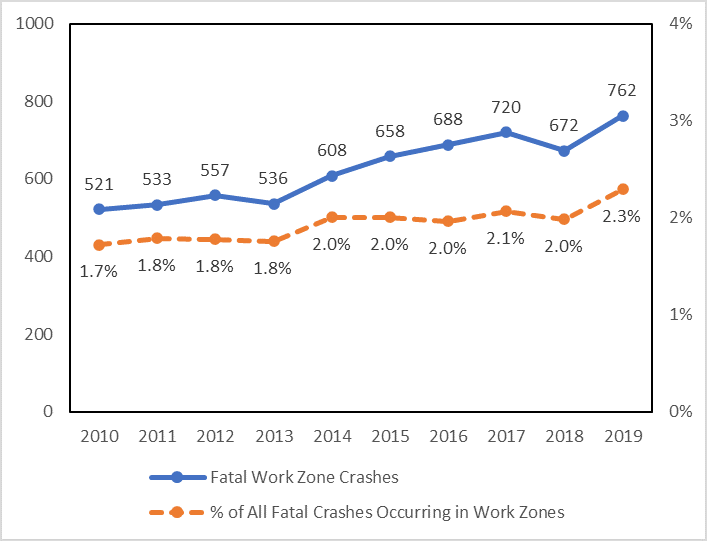
Fatal Work Zone Crashes and Percent of Fatal Crashes Occuring in Work Zones 2010–2019. (Source: NHTSA Fatality Analysis Reporting System [FARS])
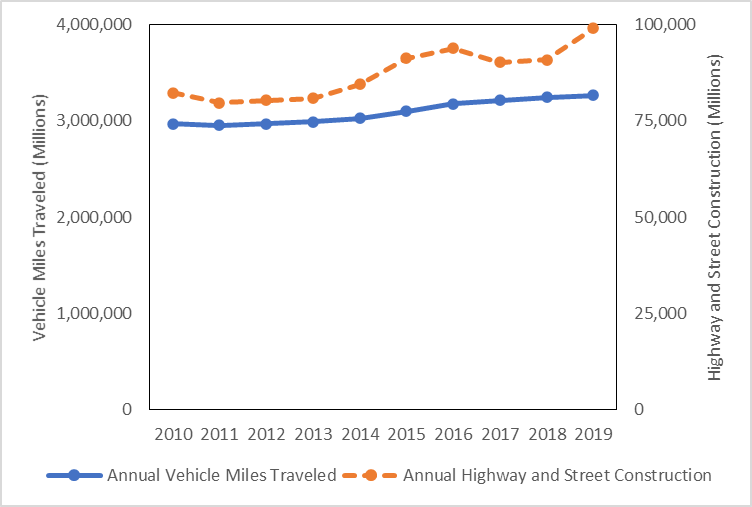
Annual Vehicle Miles Travelled and Highway/Street Construction Expenditures: 2010–2019. (Source: Bureau of Transportation Statistics and Federal Reserve Bank of St. Louis)
Unfortunately, as shown by the following statistics, work zone fatalities increased in 2019:
For NWZAW, on April 27 FHWA joined the Federal Motor Carrier Safety Administration, National Highway Traffic Safety Administration (NHTSA), American Traffic Safety Services Association, Occupational Safety and Health Administration, American Association of State Highway and Transportation Officials, American Road & Transportation Builders Association, Associated General Contractors of America, and the Michigan Department of Transportation (MDOT) to raise awareness of work zone safety during the kickoff event. As part of this effort, MDOT and the NWZAW Executive Committee developed a downloadable NWZAW poster and FHWA developed a fact sheet for widespread distribution among its work zone safety partners and stakeholders.
The 2021 theme is "Drive Safe. Work Safe. Save Lives."
Drive Safe. A reminder that work zones need everyone's undivided attention. When approaching a work zone, motorists should always slow down, follow all posted signs, be alert, and remain calm. Risky driving behavior affects more than just the driver—everyone's lives and families are at stake.
Work Safe. Technology is helping to make work zones safer by collecting data and automating processes, which can remove workers from dangerous situations and provide motorists with important information. It is also a reminder that work zone safety begins with workers who are dedicated to safety.
Save Lives. If we ALL work together, we can achieve zero deaths on our roads and in our work zones!
FHWA is also working to increase work zone safety with the Work Zone Data Exchange (WZDx) project. WZDx is an open-source data feed that makes live, accurate, and actionable work zone data available for use by third parties, such as mapping companies. The intent of the WZDx project is to make travel on public roads safer and smarter where navigation systems, drivers, and eventually automated vehicles can be informed about work zones in their path, improving roadway safety nationwide. To encourage adoption of WZDx, FHWA recently launched the "Put Work Zones on the Map" campaign, an awareness effort to educate and engage potential partners, including mapping companies, vehicle and vehicle technology manufacturers, construction companies, and State and local DOTs on the capabilities, benefits, and progress of WZDx.
For more information on work zone management training, regulations, resources, and tools visit the FHWA Work Zone Management website and the National Work Zone Safety Information Clearinghouse website.
For more information, contact Martha Kapitanov at martha.kapitanov@dot.gov.
By: Triny Willerton, It Could Be Me (nonprofit)

Triny Willerton, president of It Could Be Me. (Source: It Could Be Me)
My name is Triny Willerton. I am a wife, mom of five, triathlete, and cyclist. I was not athletic growing up but was very fortunate to have a very healthy metabolism. Everything changed when I started having my children. I gained a lot of weight with each pregnancy, and when my last baby was born, I found myself with a body I didn't like or recognize. I joined a program at my gym and successfully lost all the weight. I discovered triathlon and cycling soon after that and instantly fell in love with both. I loved how they made me feel, and I found a strength I never knew I had. I also found my best friends in the triathlon community. I started racing more and training harder. My kids were all in school, and I could do my training around their schedules. Triathlons became a fundamental part of me. I even met my husband at a race. Our dates consisted of long bike rides, which we both loved.
On May 8, 2018, I was on one of my last triathlon training rides in Boulder when a careless driver hit me with his truck. I was doing everything right, yet he hit me and changed my life forever. I was in the hospital for 6 days. My body sustained more than a dozen fractures and a punctured lung. It is a miracle that I survived and that I was able to recover the way I have. My doctors concur that it was due to how fit and strong I was.
I don't want anyone to live through what I did, and I don't want people to be scared when they are riding, or when someone they love is riding. So I have been working hard to create safer roads for all vulnerable users.
In 2019 I was involved in testifying and promoting Colorado Senate bill 175, a bill concerning penalties for drivers who cause injuries to vulnerable road users. The bill passed, and I had the honor of witnessing it being signed into law by Colorado Governor Jared Polis. This new law drastically changes the consequences for careless drivers involved in a crash in the State of Colorado.
I believe there are many layers to the problem concerning motorists and vulnerable users of the road. I recognize that people especially lack empathy for cyclists. Drivers often see us as obstacles and annoyances they have to put up with on the road. They fail to acknowledge that we are all the same. We are all people. We are moms, dads, sons, and daughters, and we want to make it back home safely every time. We need to look out for each other.

It Could Be Me logo. (Source: It Could Be Me)
I created #itcouldbeme to change all of this. My goal is to bring awareness and empathy toward all vulnerable users of the road and make long-term change. I see it as a four-fold movement:
1. A relentless visual campaign
We give identities to those otherwise anonymous bodies on bicycles to change cyclist and motorist relationships on the road. My idea is to create short videos with people from all walks of life who share something about who they are and unique things about themselves to showcase their personalities. They make a vow to follow all the rules of the road and ask motorists to look out for them and keep them safe. They post the video on their social media platforms with the hashtag #itcouldbeme. The goal is to reach the most motorists possible, especially those who already care for the person who created the video. The video is emailed to me, and I distribute it on all of It Could Be Me's social media channels.
2. Policy change
I believe it is crucial to establish vulnerable-user laws across the country. Through our ambassador program, we will serve as liaison between potential witnesses and lobbyists. We will keep our ambassador program open year-round, so it can continue to grow with us. We currently have 150 passionate ambassadors worldwide.
3. Education
I believe education is an essential part of effectively creating long-term change. We need to reach young drivers and show them what proper behavior looks like in a relationship with vulnerable users on the road. We need to reignite empathy and community in motorist and vulnerable user relationships.
4. Community outreach
It Could Be Me will help the community by providing resources and support. We created two support groups on Facebook and a webinar series:
In the future we plan to host in-person bike rides and socials with our ambassadors to promote and demonstrate acceptable behaviors on the road and strengthen our community. We will also host donation drives at local levels to provide gear to communities in need.
Last summer, we produced two projects to promote safer roads and raise awareness. We teamed up with local architectural firm Workshop8 and painted a mural. It is located on a bustling road and has been received with open arms by the community.
We fundraised for a year and produced our first public service announcement video, a 90-second clip that captures the essence of It Could Be Me. We launched it earlier this year with great success and have received incredible recognition and support. Our movement grows each day, and so do our goals. I know we will make safer roads together.
To find out more, please visit www.itcouldbeme.org.
By: Karen Scurry, FHWA Office of Safety, and Roya Amjadi, FHWA Turner-Fairbank Highway Research Center
Consider a scenario where an agency identifies head-on crashes as a focus crash type based on the number of fatal and severe injury crashes of that type. The agency notes these crashes are most prevalent on rural four-lane road segments, so it selects these segments as the focus facility type for head-on crashes. The agency reviews data for all head-on crashes that occurred on rural four-lane road segments and determines that potential contributing factors are narrow roadway cross sections (i.e., lanes and shoulders), narrow or no medians, and no median barriers (for segments with medians). The agency identifies rumble strips as an appropriate countermeasure to address the contributing factors (i.e., centerline rumble strips on undivided facilities, median shoulder or edgeline rumble strips on divided facilities). Since the agency does not have sufficient funds to install rumble strips on all rural four-lane roads, it prioritizes candidate locations and establishes thresholds for countermeasure implementation (e.g., rural four-lane roads that have lane widths narrower than 11 feet).
This scenario is an example of the systemic approach to safety. With the systemic approach, proven safety countermeasures are widely implemented based on high-risk roadway features that are correlated with particular severe crash types. As described above, and in FHWA's Systemic Safety Project Selection Tool, the first step of the systemic safety analysis process relies on crash, roadway, and traffic data to identify focus crash types, focus facility types, and potential contributing (or risk) factors.
"With the systemic approach, proven safety countermeasures are widely implemented based on high-risk roadway features that are correlated with particular severe crash types."
Agencies with sufficient data and analysis capabilities should analyze jurisdiction-specific data to identify contributing factors for various focus crash and facility types. In some cases, agencies may not have sufficient data or analysis capabilities to complete this type of analysis for their jurisdiction. Therefore, FHWA conducted a research project to analyze national and State data to identify common priorities and published the Contributing Factors for Focus Crash and Facility Types report and the Quick Reference Guide.
Summary Version
The Quick Reference Guide may be helpful to transportation professionals who are interested in applying a systemic approach to road safety management. The guide discusses:
The common target crash types, facility types, and contributing factors are based on an analysis of national and State data and serve as a quick reference for agencies interested in applying the systemic safety approach to these most common crash and facility types. Agencies can reference the contributing factors in this guide to help identify countermeasures and prioritize sites for systemic safety improvements.
| Intersection | Non-intersection |
|---|---|
| Average annual daily traffic volume (AADT) | AADT |
| Curve radius | Percent (%) trucks |
| Lane width | % Grade |
| Lane width | % Grade |
| Median width | Curve radius |
| Left/Right turn lane channelization | Surface width |
| Speed | Shoulder width |
| Shoulder type | |
| Speed | |
| Lane width | |
| Terrain |
Behind the Scenes
If you're looking for details behind the research, the full report provides a more in-depth discussion of the data sources, statistical methodologies, analysis procedures and tools, and results. In summary, the focus crash and facility type analysis revealed 17 focus crash and facility type combinations. For the contributing factors analysis, the research team used the random forest method (as described in Development of Crash Modification Factors: Highway Safety Statistical Paper Synthesis) to identify the most predictive variables. The team then created plots of random forest–predicted crash frequencies as a function of the predictor variables to observe the general trends in the relationships. This is the first known application of random forests in this context, and the report offers recommendations for future refinements when using the approach. The roadway factors the analysis uncovered as influencing the frequencies of the different crash types were generally consistent with existing practice, as well as expectations that had been based on previous research. The table below summarizes the contributing factors for intersection and non-intersection facility types identified via the research.
Table 1 and Table 2 in the Quick Reference Guide provide additional details about the applicability of these contributing factors for the different focus crash and facility type combinations.
The research also lays out a process for identifying and selecting countermeasures for focus crash types based on contributing factors. The countermeasure guidance focused on traffic and roadway findings. Findings linked to socioeconomic- and weather-related factors showed promise, but there is not yet a significant amount of theory to support or refute the socioeconomic- and weather-related results of this effort. The report summarizes countermeasures related to the contributing factors for the intersection and non-intersection focus crash and facility types, respectively.
FHWA's Evaluation of Low-Cost Safety Improvements Pooled Fund Study (ELCSI–PFS) sponsored this research. The ELCSI–PFS will offer two workshops in August 2021. The first workshop will promote the results of this research to various stakeholder communities (e.g., university transportation centers, Institute of Transportation Engineers [ITE], American Statistical Association). The second workshop will better aid practitioners and researchers in using the research products to identify and implement systemic safety improvements. Visit the ELCSI–PFS website for additional information about the study and other research efforts.
For more information contact Roya Amjadi at roya.amjadi@dot.gov or Karen Scurry at karen.scurry@dot.gov.
By Abdul Zineddin, FHWA Office of Safety, Morgan Kessler, FHWA Office of Infrastructure R&D, and Carl Andersen, FHWA Office of Safety R&D

Car with illustrated connected and automated technology. (Source: FHWA)
On March 11, 2021, FHWA released Impacts of Automated Vehicles on Highway Infrastructure.
Connected and automated vehicle technologies have the potential to enhance highway safety by performing various driver functions and maintaining appropriate driver attention to traffic and roadway conditions. Such technologies can have a tremendous impact reducing roadway crashes (e.g., lane departure warning systems that alert the driver when the vehicle drifts past the lane markings).
As the vehicle fleet transitions to include a greater percentage of these vehicles, it is important to understand how the infrastructure and safety countermeasures need to adjust to accommodate the changes.
This project specifically covers the reported impacts of automated vehicles on highway infrastructure. The goal is to provide information to stakeholders as they prepare for the eventual infrastructure evolution driven by the deployment of automated vehicles.
This project does not delve into operations or provide policy recommendations, although infrastructure impacts outlined in this report are contingent upon policy and operations decisions. This report attempts to provide infrastructure owner-operators with a list of possible impacts of initial automated vehicle deployment on roadway infrastructure and identifies research opportunities based on feedback from State and local agencies and the automated vehicle industry.
For more information, contact Abdul Zineddin at abdul.zineddin@dot.gov.

Supplemental documents to the Bikeway Selection Guide. (Source: FHWA)
By Tamara Redmon, FHWA Office of Safety
FHWA released two new resources intended to supplement its Bikeway Selection Guide:
Traffic Analysis and Intersection Considerations to Inform Bikeway Selection is intended to inform trade-off decisions associated with bikeway selection at intersections. It discusses common performance metrics, spatial needs of bikeways at intersections, safety- and equity-focused design principles, and operational traffic analysis trade-offs and assumptions.
On-Street Motor Vehicle Parking and the Bikeway Selection Process begins with a discussion of on-street parking and bikeway types, with associated dimensional requirements and trade-off considerations. It then presents several strategies involving choices specifically relating to the overlap between general purpose on-street parking and passenger or commercial loading activities, design details, and bikeway selection.
These resources establish foundational information for transportation agencies to build the safest, most effective, and most equitable bikeways for their transportation networks.
To learn more about these resources, contact Tamara Redmon at tamara.redmon@dot.gov.
By Karen Scurry, FHWA, Scott Himes, VHB, Frank Gross, VHB, Kara Peach, VHB, and Catherine Chestnutt, VHB

Countermeasure Service Life Guide. (Source: FHWA)
Transportation agencies often balance many factors when identifying and selecting appropriate countermeasures for improving roadway safety. One component of the decision-making process is a consistent and reliable method for comparing potential benefits of countermeasures for installation. When agencies are selecting and prioritizing countermeasures and projects, they need to reasonably compare the different options and often use crash modification factors (CMFs) to support the analysis. While CMFs help estimate the magnitude of a potential safety benefit, they do not reflect the service life for each countermeasure.
Service life is the number of years a countermeasure will have a noticeable effect on crashes at a location.5 Practitioners incorporate countermeasure service life in benefit-cost analysis (BCA) to support a more comprehensive and fairer comparison of alternatives in the analysis. While FHWA previously produced a synthesis of countermeasure service life values used by States, many States indicated a preference for a single source that contains typical service life for various safety countermeasures.
Overview of the Guide
The Highway Safety Manual Implementation Transportation Pooled Fund study TPF-5(255) sponsored development of the Countermeasure Service Life Guide (FHWA-21-026) for traffic and safety engineers, designers, planners, and maintenance staff who may not have experience with economic analysis. The guide intends to help these practitioners learn more about service lives and how practitioners can include service life as part of a BCA. Ultimately the guide aims to support consistent decision-making when practitioners implement safety strategies or countermeasures for safety projects and programs.
| Countermeasure Category | Service Life (years) |
|---|---|
| Access Management | 20 |
| Advanced Technology and Intelligent Transportation Systems (ITS) |
10 |
| Alignment | 20 |
| Bicycle | 1–25 |
| Delineation | 1–5 |
| Highway Lighting | 15 |
| Interchange Design | 20 |
| Intersection Geometry | 1–20 |
| Intersection Traffic Control | 1–15 |
| Pedestrian | 1–30 |
| Railroad Grade Crossings | 1–25 |
| Resurfacing | 5–10 |
| Roadside | 10–25 |
| Roadway | 1–20 |
| Shoulder Treatment | 5–20 |
| Signs | 5–20 |
| Structures | 10–30 |
| Work Zone | 1 |
| Other | 10–30 |
Jason Hershock, manager of the Safety Engineering and Risk Management unit at the Pennsylvania Department of Transportation, is looking forward to using the guide. He shared, "The new FHWA Countermeasure Service Life Guide will be a tremendous reference for the department. The reference will provide acceptable life cycles for several safety countermeasures, which will provide accurate life cycle cost analysis. Overall, the new Countermeasure Service Life Guide will help the department answer the questions, ‘Is the project worth the investment?' and ‘Which project options are the best to improve safety given the current budget?'"
The Countermeasure Service Life Guide provides typical service life values for common safety strategies and countermeasures. The development of the guide included a review of existing resources (e.g., State-agency HSIP manual documentation and State-developed countermeasure service life lists) and literature that contained information on the service life of various countermeasures. A technical panel composed of representatives from eight State DOTs met and provided suggestions based on their experiences. The guide organizes the common countermeasures into 19 categories (shown in the table below), which is consistent with those found in the CMF Clearinghouse. The guide provides a single service life value for each countermeasure, and the list includes the range for the typical service life associated with each category.
Potential Applications and Benefits
Countermeasure service life is a key component of the BCA process. Specifically, practitioners can use service life values to select an appropriate analysis period and to use the equations to convert annual maintenance and operations costs to present dollar values. So, it is important that transportation practitioners use a consistent approach and service life values when comparing and prioritizing potential projects. The guide walks through several safety project examples for selecting and applying the service life in a BCA. The examples include practical applications of service life in the BCA process for:
Practitioners can use the guide to develop a service life list, which is similar to a CMF list. A service life list offers several benefits, such as creating standardized values that improve how an agency consistently applies BCA on proposed projects. Practitioners like Kevin Scopoline, traffic operations and analysis engineer with WisDOT, shared, "Wisconsin DOT plans on incorporating this guide into our safety analysis process to help compare alternatives as part of the benefit-cost analysis."
A State-specific service life list will help staff communicate more clearly to decision makers the reasons for selecting a particular countermeasure as well as promote consistent BCA throughout an agency. While the guide provides typical service life values for common countermeasures, it also describes factors that can impact service life.
Availability
The Countermeasure Service Life Guide is available online.
For more information contact Karen Scurry at Karen.Scurry@dot.gov or 202.897.7168.
By Chimai Ngo, FHWA Office of Safety
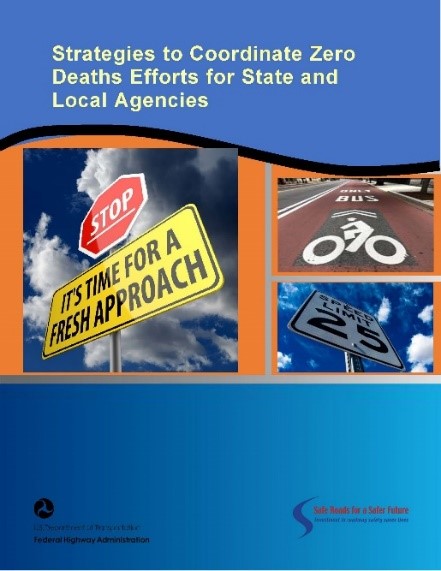
Cover of Strategies to Coordinate Zero Deaths Efforts for State and Local Agencies. (Source: FHWA)
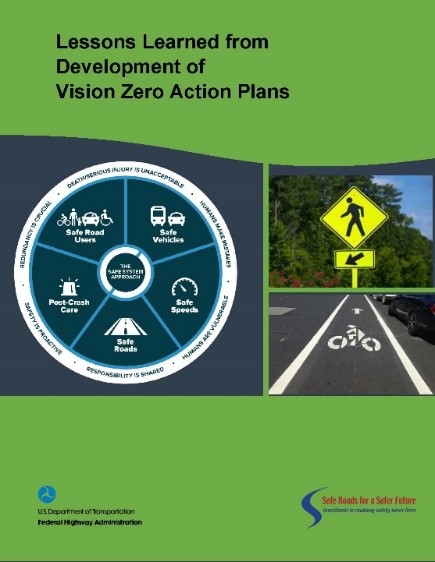
Cover of Lessons Learned from Development of Vision Zero Action Plans. (Source: FHWA)
Are you planning to work with other agencies within your State to further efforts to reach the shared goal of zero deaths? Or are you considering developing a Vision Zero action plan as a roadmap to your Vision Zero implementation? If you are, FHWA recently published two reports that document efforts to collaborate with several State and local partners to do just that. The agency offers these reports to Tribal, State, regional, and local transportation partners with recent information so you can build on the efforts of others.
Strategies to Coordinate Zero Deaths Efforts for State and Local Agencies provides examples from communities, metropolitan planning organizations, and State DOTs that have built and fostered relationships through strategies that work toward a Safe System Approach and reach the zero deaths goal. In 2019, FHWA worked with stakeholders from Texas, Florida, and Colorado. In each State, FHWA hosted an in-person workshop and a webinar. Workshop and webinar participants shared activities that exemplify coordination and collaboration, and discussed advancing a Safe System Approach as critical to reach the zero deaths goal. Participants highlighted ways to move toward that goal, including managing speed for safety, strengthening safety culture, and leveraging data and community input to prioritize safety. The report also includes notable strategies that other State, regional, and local agencies have implemented in their efforts to reach their shared safety goal.
The Lessons Learned from Development of Vision Zero Action Plans report summarizes the Vision Zero action plan development processes of two communities: Dale City, California, and Macon-Bibb County, Georgia. The report draws from the experiences of both communities and summarizes the common themes adapted in both processes. One common theme is the inclusion and application of the Safe System Approach to the extent possible. The report also offers information on challenges the communities faced and opportunities taken. In addition, the report not only describes lessons learned but also anticipates chances to take advantage of future opportunities moving forward.
For more information, contact chimai.ngo@dot.gov or visit https://safety.fhwa.dot.gov/zerodeaths/resources.cfm.

New FHWA Office of Safety logo. (Source: FHWA)
Notice something new and a little different? The Office of Safety is excited to launch a new logo and tagline: "Zero is our goal, a safe system is how we get there."
Our new branded look emphasizes our vision of zero deaths through implementation of the Safe System Approach. The logo features an arrow, depicting a road that visually represents the downward statistical trend of highway fatalities we are all working towards.

Home page of the new intersection safety web page. (Source: FHWA)
By Jeffrey B. Shaw, P.E., FHWA Office of Safety
As part of the overall agency effort to update and streamline web pages, the Intersection Safety program has undergone a complete overhaul. The new Intersection Safety web pages are structured to make the most-visited content easier to find. The new content strategy also reduces redundancies with other safety program pages.
The updated structure starts with the Intersection Safety home page. From there, a visitor can choose from the following subcategory pages: About Intersection Safety, Intersection Control Evaluation, Safe System Intersections, Stop-Controlled Intersections, Corridor Access Management, Roundabouts, Crossover Intersections, Reduced Left-Turn Conflict Intersections, Signalized Intersections, and Other Intersection Designs.
The Intersection Safety team is excited about these changes! We hope this refresh makes for more informative and productive visits to our web pages!
For more information, contact Jeff Shaw at jeffrey.shaw@dot.gov.
NCHRP recently published a Guide for Quantitative Approaches to Systemic Safety Analysis (Research Report 955). This document is intended to help safety engineers and managers better understand systemic safety management concepts to apply them in practice, as well as to help them better explain systemic safety management-based decisions to stakeholders. Specifically, the guide:
For more information and to download the report, go to http://www.trb.org/main/blurbs/181589.aspx.
National Association of Counties (NACo) Annual Conference and Exposition. Location pending. July 9–12, 2021.
The NACo annual conference is a meeting of county-elected and appointed officials from across the country coming together to shape NACo's Federal policy agenda, share proven practices, and strengthen knowledge networks.
National Rural ITS Conference + Exhibit. Virtual. July 18–20, 2021.
Transportation professionals engaged in our transportation system will find tools and networking opportunities.
ITE Annual Meeting and Exhibition. Virtual. July and August 2021.
The ITE Annual Meeting will be a virtual event in 2021. The technical program will run July 20–29 and the council and committee meetings will be held August 3–4.
American Public Works Association (APWX) Public Works Expo (PWX). St. Louis, Missouri. August 29–September 1, 2021.
The annual PWX multimodal learning experience is designed for professionals involved in public works.
Governors Highway Safety Association (GHSA) Annual Meeting. Denver, Colorado. September 11–15, 2021.
This year the theme is "Moving Mountains: Forging a New Traffic Safety Landscape."
ITS America 2021 Annual Meeting. Charlotte, North Carolina. December 7–10, 2021.
The event brings together intelligent transportation community stakeholders from across the country. The meeting date has been moved to later in the year to remain an in-person event.
is a publication of the U.S. Department of Transportation, Federal Highway Administration (FHWA).
FHWA publishes the Safety Compass newsletter 3 times a year. We can be reached at:
FHWA Office of Safety
1200 New Jersey Ave. SE
Room E71-320
Washington, DC 20590
The Safety Compass is available online at the FHWA Office of Safety web site at: https://safety.fhwa.dot.gov/newsletter/safetycompass/.
We welcome your comments and highway safety-related articles. The purpose of this newsletter is to increase highway safety awareness and information and to provide resources to help save lives.
We encourage readers to submit highway safety articles that might be of value to the highway safety community. Send your comments, questions, and articles for review electronically to Tara McLoughlin at: tara.mcloughlin@dot.gov.
1 According to the NHTSA FARS Annual Report File, 2019. [ Return to note 1. ]
2 NHTSA, FARS 2010–2018 Final File and 2019 Annual Report File; FARS data shown here are from the 50 States, the District of Columbia, and Puerto Rico. [ Return to note 2. ]
3 NHTSA, FARS 2019 Traffic Fatality Data; FARS data shown here are from the 50 States, the District of Columbia, and Puerto Rico. [ Return to note 3. ]
4 U.S. Department of Labor, Bureau of Labor Statistics, 2019. [ Return to note 4. ]
5 American Association of State Highway and Transportation Officials, Highway Safety Manual, 1st edition (Washington, DC, 2010). [ Return to note 5. ]
